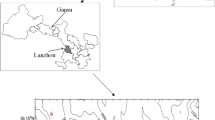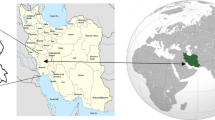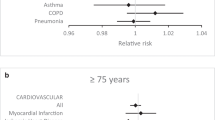Abstract
Although Ahvaz is considered as one of the warmest cities around the world, few epidemiological studies have been conducted on the adverse effects of temperature on human health using thermal indices in this city. This study investigates the relation between physiologically equivalent temperature (PET) and respiratory hospital admissions in Ahvaz. Distributed lag non-linear models (DLNMs) combined with quasi-Poisson regression models were used to investigate the relation between PET and respiratory disease hospital admissions, adjusted for the effect of time trend, air pollutants (NO2, SO2, and PM10), and weekdays. The analysis was performed by utilizing R software. Low PET values significantly decreased the risk of hospital admissions for total respiratory diseases, respiratory diseases in men and women, chronic obstructive pulmonary diseases (COPD), and bronchiectasis. However, low PET (16.9°C) in all lags except lag 0–30 significantly increased the risk of hospital admissions for asthma. The results indicate that in Ahvaz, which has a warm climate, cold weather decreased overall respiratory hospital admissions, except for asthma.

Similar content being viewed by others
References
Abdel-Ghany A, Al-Helal I, Shady M (2013) Human thermal comfort and heat stress in an outdoor urban arid environment: a case study. Adv Meteorol 2013:1–7
Alizadeh-Choobari O, Najafi M (2018) Extreme weather events in Iran under a changing climate. Clim Dyn 50:249–260
Anderson GB, Dominici F, Wang Y, McCormack MC, Bell ML, Peng RD (2013) Heat-related emergency hospitalizations for respiratory diseases in the Medicare population. Am J Respir Crit Care Med 187:1098–1103
Buckley JP, Richardson DB (2012) Seasonal modification of the association between temperature and adult emergency department visits for asthma: a case-crossover study. Environ Health 11:55
Bunker A, Wildenhain J, Vandenbergh A, Henschke N, Rocklöv J, Hajat S, Sauerborn R (2016) Effects of air temperature on climate-sensitive mortality and morbidity outcomes in the elderly; a systematic review and meta-analysis of epidemiological evidence. EBioMedicine 6:258–268
Chen T-H, Du XL, Chan W, Zhang K (2019) Impacts of cold weather on emergency hospital admission in Texas, 2004–2013. Environ Res 169:139–146
D’Amato G et al (2015a) Meteorological conditions, climate change, new emerging factors, and asthma and related allergic disorders. A statement of the World Allergy Organization. World Allergy Organization J 8:1–52
D’amato G et al (2015b) Effects on asthma and respiratory allergy of Climate change and air pollution. Multidiscipl Respir Med 10:1–8
Donaldson G, Seemungal T, Jeffries D, Wedzicha J (1999) Effect of temperature on lung function and symptoms in chronic obstructive pulmonary disease. Eur Respir J 13:844–849
Eccles R (2002) An explanation for the seasonality of acute upper respiratory tract viral infections. Acta Otolaryngol 122:183–191
Epstein Y, Moran DS (2006) Thermal comfort and the heat stress indices. Ind Health 44:388–398
Fröhlich D, Gangwisch M, Matzarakis A (2019) Effect of radiation and wind on thermal comfort in urban environments-application of the RayMan and SkyHelios model. Urban Clim 27:1–7
Gasparrini A, Armstrong B, Kenward MG (2010) Distributed lag non-linear models. Stat Med 29:2224–2234
Gasparrini A, Guo Y, Hashizume M, Lavigne E, Zanobetti A, Schwartz J, Tobias A, Tong S, Rocklöv J, Forsberg B, Leone M, de Sario M, Bell ML, Guo YLL, Wu CF, Kan H, Yi SM, de Sousa Zanotti Stagliorio Coelho M, Saldiva PHN, Honda Y, Kim H, Armstrong B (2015) Mortality risk attributable to high and low ambient temperature: a multicountry observational study. Lancet 386:369–375
Giesbrecht GG (1995) The respiratory system in a cold environment. Aviat Space Environ Med 66:890–902
Guha-Sapir D, Below R, Hoyois P (2016) The CRED/OFDA international disaster database. Nature
Haines A, Ebi K (2019) The imperative for climate action to protect health. N Engl J Med 380:263–273
Hansel NN (2016) McCormack MC, Kim V. The effects of air pollution and temperature on COPD COPD: J Chronic Obstructive Pulmonary Disease 13:372–379
Idani E, Dastoorpoor M, Goudarzi G, Khanjani N (2016) Severe outbreaks of respiratory syndromes following autumn rainfall in Khuzestan. Iran. Archives of Iranian Medicine 19:884–885
Jenkins C et al (2012) Seasonality and determinants of moderate and severe COPD exacerbations in the TORCH study. Eur Respir J 39:38–45
Lai PC et al (2018) Constructing a map of physiological equivalent temperature by spatial analysis techniques. In: Comprehensive geographic information systems. Elsevier, pp 389–401
Lee H, Mayer H (2016) Validation of the mean radiant temperature simulated by the RayMan software in urban environments. Int J Biometeorol 60:1775–1785
Leon LR, Helwig BG (2010) Heat stroke: role of the systemic inflammatory response. J Appl Physiol 109:1980–1988
Lin S, Luo M, Walker RJ, Liu X, Hwang S-A, Chinery R (2009) Extreme high temperatures and hospital admissions for respiratory and cardiovascular diseases. Epidemiology 20:738–746
Lin Y-K, Chang C-K, Li M-H, Wu Y-C, Wang Y-C (2012) High-temperature indices associated with mortality and outpatient visits: characterizing the association with elevated temperature. Sci Total Environ 427:41–49
Luo Y, Zhang Y, Liu T, Rutherford S, Xu Y, Xu X, Wu W, Xiao J, Zeng W, Chu C, Ma W (2013) Lagged effect of diurnal temperature range on mortality in a subtropical megacity of China. PLoS One 8:e55280
Malik A, Johnson A, Tahamont M, van der Zee H, Blumenstock F (1983) Role of blood components in mediating lung vascular injury after pulmonary vascular thrombosis. Chest 83:21S–24S
Mannino DM (2011) The natural history of chronic obstructive pulmonary disease. Advances in Respir Med 79:139–143
Michelozzi P, Accetta G, de Sario M, D'Ippoliti D, Marino C, Baccini M, Biggeri A, Anderson HR, Katsouyanni K, Ballester F, Bisanti L, Cadum E, Forsberg B, Forastiere F, Goodman PG, Hojs A, Kirchmayer U, Medina S, Paldy A, Schindler C, Sunyer J, Perucci CA, PHEWE Collaborative Group (2009) High temperature and hospitalizations for cardiovascular and respiratory causes in 12 European cities. Am J Respir Crit Care Med 179:383–389
NOAA (2017) Climate at a glance: Global Time Series
Saboohi R, Soltani S, Khodagholi M (2012) Trend analysis of temperature parameters in Iran. Theor Appl Climatol 109:529–547
Sharafkhani R, Khanjani N, Bakhtiari B, Jahani Y, Tabrizi JS (2018) Physiological equivalent temperature index and mortality in Tabriz (the northwest of Iran). J Therm Biol 71:195–201
Sharafkhani R, Khanjani N, Bakhtiari B, Jahani Y, Tabrizi JS, Tabrizi FM (2019) Diurnal temperature range and mortality in Tabriz (the northwest of Iran). Urban Clim 27:204–211
Son J-Y, Bell ML, Lee J-T (2014) The impact of heat, cold, and heat waves on hospital admissions in eight cities in Korea. Int J Biometeorol 58:1893–1903
Statistical-Centre-of-Iran (2016) Data on the 2016 census. Available at: https://wwwamarorgir
Sun S, Cao W, Mason TG, Ran J, Qiu H, Li J, Yang Y, Lin H, Tian L (2019) Increased susceptibility to heat for respiratory hospitalizations in Hong Kong. Sci Total Environ 666:197–204
Tseng C-M, Chen YT, Ou SM, Hsiao YH, Li SY, Wang SJ, Yang AC, Chen TJ, Perng DW (2013) The effect of cold temperature on increased exacerbation of chronic obstructive pulmonary disease: a nationwide study. PLoS One 8:e57066
White MD (2006) Components and mechanisms of thermal hyperpnea. J Appl Physiol 101:655–663
Zhang Y, Zhao Q, Zhang W, Li S, Chen G, Han Z, Guo Y (2017) Are hospital emergency department visits due to dog bites associated with ambient temperature? A time-series study in Beijing, China. Sci Total Environ 598:71–76
Zhang A, Hu W, Li J, Wei R, Lin J, Ma W (2019) Impact of heatwaves on daily outpatient visits of respiratory disease: a time-stratified case-crossover study. Environ Res 169:196–205
Zhao Q, Zhao Y, Li S, Zhang Y, Wang Q, Zhang H, Qiao H, Li W, Huxley R, Williams G, Zhang Y, Guo Y (2018) Impact of ambient temperature on clinical visits for cardio-respiratory diseases in rural villages in northwest China. Sci Total Environ 612:379–385
Acknowledgements
The authors wish to express their gratitude to Ms. Yalda Sabaghan for her kind assistance.
Availability of data and materials
Not applicable
Funding
This study was funded and supported by Ahvaz Jundishapur University of Medical Sciences (Grant No. APRD-9913).
Author information
Authors and Affiliations
Contributions
SHB and MD designed the project. MD acquired the data. MD analyzed and interpreted the data. NK1 and NK2 wrote the paper. All authors approved the final text.
Corresponding author
Ethics declarations
Ethics approval and consent to participate
The proposal of this study was approved by the Ethics Committee of Ahvaz Jundishapur University of Medical Sciences (IR.AJUMS.REC.1399.866).
Consent for publication
Not applicable
Competing interests
The authors declare no competing interests.
Additional information
Responsible Editor: Lotfi Aleya
Publisher’s note
Springer Nature remains neutral with regard to jurisdictional claims in published maps and institutional affiliations.
Rights and permissions
About this article
Cite this article
Borsi, S.H., Khodadadi, N., Khanjani, N. et al. Physiological equivalent temperature (PET) index and respiratory hospital admissions in Ahvaz, southwest of Iran. Environ Sci Pollut Res 28, 51888–51896 (2021). https://doi.org/10.1007/s11356-021-14345-z
Received:
Accepted:
Published:
Issue Date:
DOI: https://doi.org/10.1007/s11356-021-14345-z




